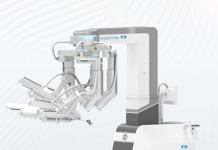Cornerstone Robotics and researchers at the Chinese University of Hong Kong (CUHK) say they made a breakthrough in surgical robotics.
According to a news release, this collaboration successfully developed an embodied intelligence platform for multi-task surgical automation. The researchers and company claim it marks the world’s first platform of this kind. They also completed the first clinical validation of autonomous surgery using Cornerstone Robotics’ Sentire endoscopic surgical system.
This marks the first successful in vivo animal testing using a Chinese-developed laparoscopic surgical robot equipped with AI-powered embodied intelligence, the company says. Researchers published their findings in Science Robotics. Outcomes demonstrate the system’s clinical feasibility as the company seeks to enable more collaborative, accessible robotic surgery.
Related: Monogram announces first autonomous robotic knee replacement procedure
The research introduced new, purely vision-based surgical embodied intelligence framework. This contrasts to traditional methods in autonomous surgery that rely on sensors or pre-defined models and rules, the company says. It features full perception, multitask applicability, precise closed-loop control and human-robot cooperation functions. The research team trained multiple AI frameworks using an independently developed open-source surgical embodied intelligence simulator.
To simulate real surgical settings, the team conducted experiments using ex vivo porcine stomach tissue. Both tests utilized the Cornerstone Robotics Sentire system. The robot autonomously executed several surgical assistive tasks and demonstrated adaptability to environmental changes.
“We firmly believe that deep integration between research and industry is the driving force behind breakthroughs in advanced medical technologies,” said Professor Samuel Au, Founder and CEO of Cornerstone Robotics. “This collaboration not only validates the real-world application of embodied AI on a commercial robotic surgical platform but also showcases their vast potential in surgical automation. We will continue to work with international researchers and clinical partners to explore new eras in task automation, human-robot collaboration, and intelligent system monitoring mechanisms, to accelerate the path toward real clinical application of smart surgical robots.”






